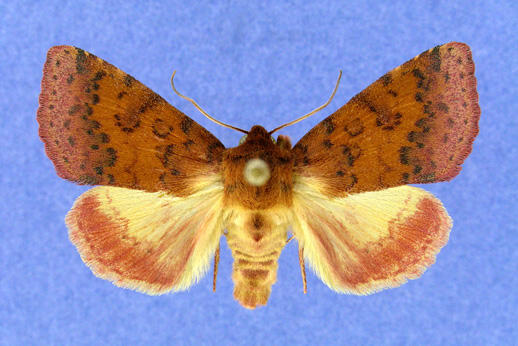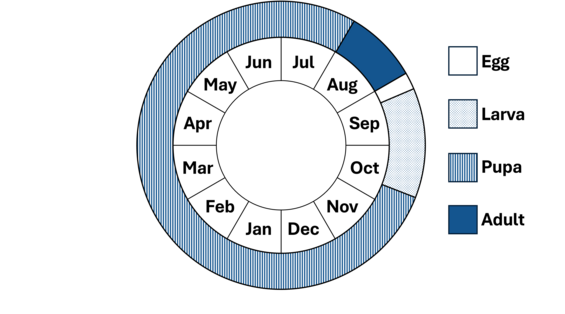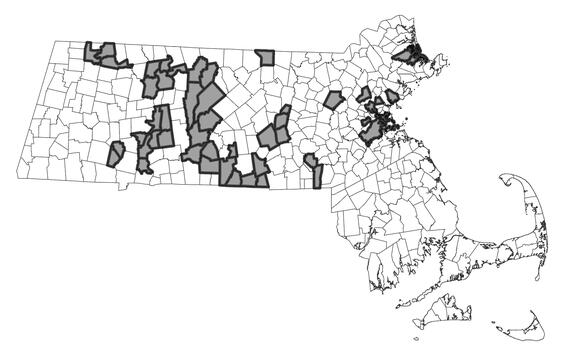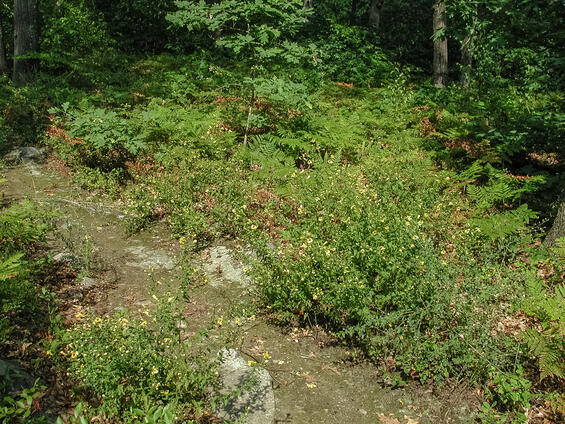- Scientific name: Pyrrhia aurantiago
- Species of Greatest Conservation Need (MA State Wildlife Action Plan)
- Special Concern (MA Endangered Species Act)
Description

Orange sallow moth, Pyrrhia aurantiago
The orange sallow (Pyrrhia aurantiago) is a noctuid moth with a wingspan of 25-33 mm (1.0-1.3 in) (Covell 1984). The forewing is orange, with the outer wing margin pink in the male. The postmedial and antemedial lines consist of wavy lines of black spots. An obscure median line may be present, especially toward the inner margin. The reniform and orbicular spots are faintly, often incompletely, outlined in black. The hind wing is yellowish tan, shaded with orange at the outer margin (reddish-orange in the male). The head and thorax are concolorous with the orange of the forewing, and the abdomen is the same yellowish tan color of the hind wing, often tinged with orange or reddish orange.
Life cycle and behavior
Adult orange sallow moths fly in August. Eggs hatch soon after they are laid, and larvae feed on the flowers, developing seeds, and foliage of false foxgloves (Aureolaria pedicularia and A. flava) through mid-October. Pupae overwinter and diapause through the following spring and summer.

Distribution and abundance
The orange sallow moth is spottily distributed from Maine south to Florida, west to Wisconsin and Texas (Covell 1984). In Massachusetts, this species occurs in scattered colonies from the North Shore and Boston west to the Berkshires but is absent from the southeast coastal plain.

Distribution in Massachusetts.
1999-2024
Based on records in the Natural Heritage Database.
Habitat
In Massachusetts, the orange sallow moth inhabits open oak woodland with false foxgloves (Aureolaria pedicularia and A. flava), typically on rocky uplands (ridges, hilltops, and steep slopes). The moth and its host plants may be found in anthropogenic openings within such habitat, for example edges of old fields and utility line rights-of-way.
Healthy habitats are vital for supporting native wildlife and plants. Explore habitats and learn about conservation and restoration in Massachusetts.

Opening in oak woodland on rocky upland with fern-leaved false foxglove (Aureolaria pedicularia), habitat for the orange sallow moth. Habitat managed by Worcester Conservation Commission at Perkins Farm.
Threats
The orange sallow moth is threatened by habitat loss and fire suppression in its disturbance-dependent habitat, specifically oak woodland on rocky uplands. Other potential threats include introduced generalist parasitoids, aerial insecticide spraying, non-target herbicide application, excessive deer browse of larval host plants, and off-road vehicles. The effects of a warming climate may not be detrimental to this species in Massachusetts; its range extends south to Florida, suggesting adaptation to warm temperatures.
Conservation
Land protection and habitat management are the primary conservation needs of this species in Massachusetts. In particular, oak woodland on rocky uplands should be conserved, restored, and managed to maintain habitat for this species and other species dependent on such habitat.
Survey and monitoring
The distribution of the orange sallow moth in Massachusetts is well documented. Known populations of this species should be surveyed to document persistence at least once every 25 years; every 10 years is more desirable when practicable.
Management
Management of oak woodland on rocky uplands benefits a suite of rare species, and habitat condition should be monitored and management adapted as needed. For the orange sallow moth, open oak woodland with abundant false foxgloves (Aureolaria pedicularia and A. flava) is of particular importance.
Research needs
The natural history and conservation needs of the orange sallow moth are relatively well known. However, as with other species with a geographic range mostly south of Massachusetts, the future effects of a warming climate on this species are unpredictable and should be documented.
References
Covell, C.V. 1984. A Field Guide to Moths of Eastern North America. Peterson Field Guide Series. Houghton Mifflin, Boston, Massachusetts. 496 pp.
Contact
| Date published: | March 24, 2025 |
|---|